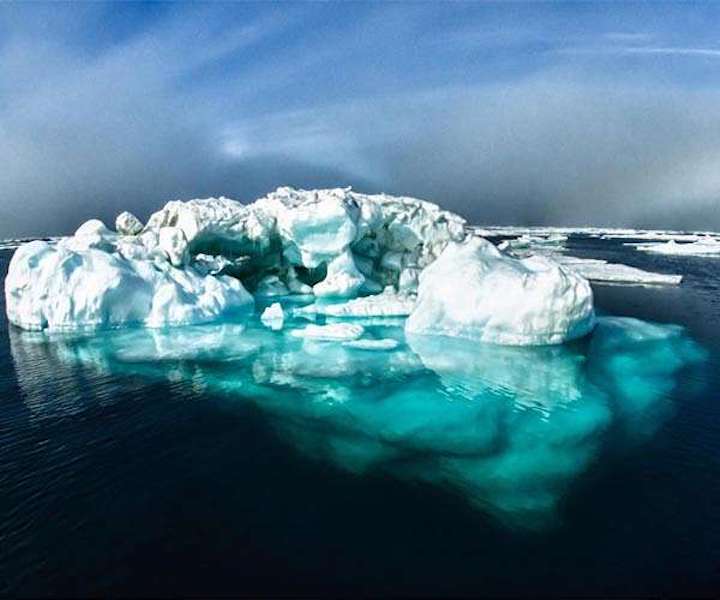21.12.2021

The National Oceanic and Atmospheric Administration's 2021 Arctic report card shows a region transformed by human-caused climate change, a thawing of a once reliably frozen region.
"The Arctic Report Card continues to show how the impacts of human-caused climate change are propelling the Arctic region into a dramatically different state than it was in just a few decades ago," said NOAA Administrator Rick Spinrad. "The trends are alarming and undeniable. We face a decisive moment. We must take action to confront the climate crisis."
The Arctic Report card is compiled by 111 scientists and 11 nations. The October-December 2020 period was the warmest Arctic autumn on record dating back to 1900.
Human-caused climate change effects on the Arctic include loss of sea ice volume, a deteriorating Greenland ice sheet and some of the fastest rates of ocean acidification in the Arctic ocean.
The thawing has also increased shipping in the region, which in turn is creating more garbage and debris along Arctic shorelines.
Scientists warned Monday that an ice shelf holding a crucial Antarctic glacier could break up within the next five years.
If that happens, it could greatly increase sea level rise by as much as 25 percent.
The Thwaites Eastern Ice Shelf supports one-third of the Florida-size Thwaites Glacier.
Millions of people living in coastal areas would be endangered by that estimated 10-13 feet of sea level rise.
NOAA's Arctic report is like an annual health climate checkup for the region. It's a very significant biome. It continues to warm twice as fast as the rest of the Earth and is rapidly losing ice cover.
That thawing Arctic permafrost releases more greenhouse gases into Earth's atmosphere, which can accelerate global warming.
Quelle: SD
+++
'Alarm bells' as UN validates record Arctic temperature
The UN on Tuesday officially recognised the 38 degrees Celsius measured in Siberia last year as a new record high for the Arctic, sounding "alarm bells" over climate change.
The sweltering heat -- equivalent to 100.4 degrees Fahrenheit -- was seen on June 20, 2020 in the Russian town of Verkhoyansk, marking the highest temperature ever recorded above the Arctic Circle, the World Meteorological Organization said.
This is the first time the WMO has added record heat in the Arctic to its archive of extreme weather reports, and it comes amid an unprecedented wave of record temperature spikes globally, the UN agency said.
"This new Arctic record is one of a series of observations reported to the WMO Archive of Weather and Climate Extremes that sound the alarm bells about our changing climate," its chief Petteri Taalas said in a statement.
Verkhoyansk lies about 115 kilometres (70 miles) north of the Arctic Circle and temperatures have been measured there since 1885.
The temperature, which the agency pointed out was "more befitting the Mediterranean than the Arctic", was measured at a meteorological station during an exceptionally prolonged Siberian heatwave.
The average temperatures across Arctic Siberia reached up to 10C above normal for much of the summer last year, it said, adding that this had fuelled fires and massive sea-ice loss.
The heatwave also played a significant role in 2020 being designated one of the three warmest years on record globally.
Last year also saw a new record high of 18.3C for the Antarctic continent, Taalas said.
The WMO is still seeking to verify the 54.4C recorded in both 2020 and 2021 in the world's hottest place, Death Valley in California.
And its experts are also working on validating a new European temperature record of 48.8C reported on the Italian island of Sicily this past summer.
The WMO's archive "has never had so many ongoing simultaneous investigations", Taalas said.
- New category -
The archive tracks the world's highest and lowest temperatures, rainfall, heaviest hailstone, longest dry period, maximum gust of wind, longest lightning flash and weather-related mortalities.
Adding record Arctic heat was in recognition of the dramatic changes in the region.
Although all parts of the planet are warming, some areas are heating faster than others -- and the Arctic's pace of change is more than twice the global average.
"This investigation highlights the increasing temperatures occurring for a climatically important region of the world," said agency weather expert Randall Cerveny.
The creation of the new category means both polar regions are now represented, after WMO added temperature extremes for the Antarctic region in 2007.
Since this was a new climate category in the archive, the experts did not provide a previous record temperature for the region, but said they had established that no temperatures of 38C or above had ever been measured there previously.
The lowest temperature ever measured above the Arctic Circle was -69.6C (-93.9F), and recorded on December 22, 1991 on Greenland, WMO said.
Quelle: SD
